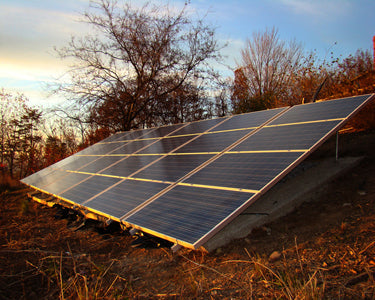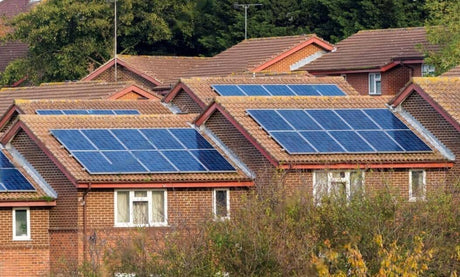As natural disasters and severe weather events become increasingly common, more and more people are interested in creating resilient solar power systems. Having access to power during grid outages can ensure you stay comfortable and safe. But not all solar systems are created equally. Just because you have solar panels does not mean you'll be able to have access to power during an outage. Here's what to know about building a resilient solar power system that can endure any sort of outage or crisis.
What does it mean to have resilient power?
For solar installation to be considered resilient, it must be able to operate independently from the grid during an outage. Off-grid solar installations or systems with battery storage can be a great way to ensure you continue to have access to energy in case of grid outages. Many people purchase gas-powered generators as a solution for providing power, but that is not the quietest, sustainable, or even most cost-effective solution. Additionally, in case of catastrophes, fuel supplies can become vulnerable to contamination or shortages.
What are the different solar power systems?
When designing a solar installation you can choose from an on-grid, off-grid, or hybrid system.
Off-grid solar systems (stand-alone power systems)
Off-grid systems utilize a battery bank to store energy produced from solar panels. Instead of being connected to the grid, you simply tap into your battery bank at night or when there's too little sunlight. Off-grid systems are a great option for those living in a remote area without reliable and affordable access to the grid.
On-grid systems (grid-tie solar systems)
On-grid systems are the most comm on and widely used systems. Grid-tied systems do not rely on a battery bank when your panels are not producing. Instead, they just tap into the grid. An important thing to consider is on-grid systems do not function during a blackout. This is because it would be a safety concern for a system to push power into the grid when utility workers may be out making repairs to the network.
On-grid systems with battery storage
As the cost of batteries continues to drop, more people are choosing to add battery storage to their on-grid projects to be able to take advantage of the benefits of both on- and off-grid systems, such as ensuring you have energy access during blackouts and paying for less energy from the grid. To work during an outage, an on-grid system with battery storage needs to have the proper technology to disconnect from the grid. Your solar system will then be able to provide power to your home by accessing your stored power in your battery bank even when the grid is down
Will solar panels keep the lights on during a blackout?
Not all solar installations are created equally, and just because you have solar panels doesn't mean you'll be able to access power during a blackout. As a general rule of thumb, if you have battery storage, you'll be able to power your home's devices and appliances with your solar installation.
Grid-tied: Will not work during a blackout.
If you are connected to the grid, then you most likely will not be able to access power during a blackout. This is because it would be dangerous for your system to be running and pushing energy into the grid while utility workers are out trying to repair the system.
Off-grid and hybrid systems: Will work during a blackout.
In order to maintain power during a blackout, you'll need to have battery storage, a solar power station, or a gas-powered generator. The cost of batteries continues to decrease, but they are still an investment. If you don't have the budget for a sizable battery bank, back-up generators are often a less-expensive solution. Solar power stations or gas-powered generators can keep the lights on when the grid goes down. However, as noted earlier, fuel can be difficult to come by during emergencies, so relying on a gas-powered generator may not be the way to go.
What do you need for a resilient solar system?
Renogy has a variety of solar kits designed specifically for use with a battery bank. Many of these can be designed to be resilient to any sort of outage. Renogy solar panel kits come with most everything to power up your cabin or home. You'll still need to purchase a separate inverter and battery bank to be able to stay powered up in case of grid outages. If you are connecting to the grid, you'll also want to consult with a professional to make sure you have the proper technology to disconnect in order to make your system rely solely on battery power in case of outages.
How do I install a resilient solar installation?
1. Evaluate your energy needs
The Renogy solar panel calculator makes it easy to help determine your specific energy needs. The solar sizing calculator allows you to input information about your lifestyle to help you decide on your solar panel requirements.
2. Off-grid or grid-tied with a battery bank?
Off-grid and hybrid systems are your best bets for ensuring you'll have energy access during power outages or severe weather events.
The benefits of off-grid systems are having ultimate energy independence and sustainable lifestyle. That said, there's no peace of mind from being able to use the grid when your system needs servicing or there is bad weather. You'll also need more equipment and have higher initial costs to cover.
The benefits of hybrid systems are having to use less energy than a traditional grid-tied system, while also having the added security of being able to tap into the grid if you need it. The downside of hybrid systems are that they require expensive equipment to cover energy storage needs, as well as connections to the grid. Likewise, you'll need space for all that equipment, which you may not have if you're not in an isolated rural location.
3. Shop for a DIY solar panel kit
Solar panel kits make it easy to ensure that you have all the parts you need and that they will safely and efficiently work together.
4. Select Your Batteries
If you're going off-grid or want to have energy storage in your system, you'll need to research to decide what battery is best for you. Lithium iron phosphate batteries are the most expensive options, but also last four times longer than lead-acid batteries and weigh much less. They also require very limited maintenance. When it comes to building a powerful and resilient system, we highly recommend investing in lithium iron phosphate batteries.
5. Permitting and Installation
If you're installing panels on a cottage, cabin, or home, do your research to see what building codes say and what permitting is required. Check with your state energy office, local officials, or a local renewable energy organization to see what requirements exist to make sure you adhere to specific rules, regulations and building codes.
Once all your necessary paperwork is in place (if stay applicable to you), then it's time for the actual installation. Renogy's DIY kits include specifications about how to install the technology, but it never hurts to consult with a professional.
Conclusion
In order to build a resilient solar power installation, it is crucial that you do the research to understand what components you need to ensure you can disconnect from the grid in case of outages, emergencies, or natural disasters. On-grid systems with battery storage or off-grid systems are two solar installation types that can be built to operate independently from the grid and give you energy access when you need it most.










